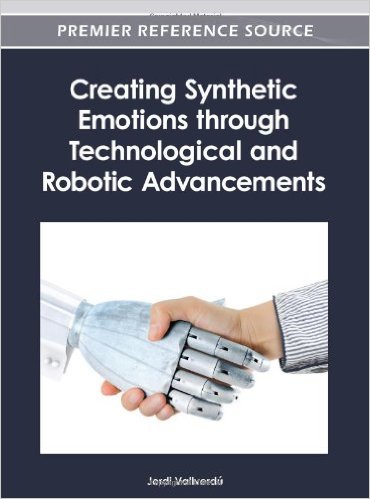 Editor: Jordi Vallverdu
Editor: Jordi Vallverdu
Publisher: IGI Global – 219 pages
Book Review by: Nano Khilnani
I bet most of you have not heard of the term ‘synthetic emotion’! These are words from two different fields quite unrelated to each other: physics and psychology. But there is one area of research that is studying synthetic emotions, and that is artificial intelligence, or AI for short.
Current-day research on artificial emotions has two principal but limited interests, as written in the Preface of this book (not bylined; should we assume this has been written by Jordi Vallverdu?):
- Recognize and imitate human emotions
- Consider the benefits of an emotion-like architecture or functioning (neural nets) for a cognitive system
This is a book about some issues most of us have given very little thought to, so it is startling to learn what researchers are thinking about and even working in the field of artificial intelligence.
For example, aren’t you shocked when you read: “the real goal of the research on artificial emotions is to create machines that are able to feel.”
Unbelievable. You wonder if that is at all even possible. So here are some qualifiers you will find in this quoted passage, which immediately follows the above quote in bold (italicized portions are ours), but most of you likely get even more shocked to read this:
“Not to feel as human beings, in the same way that airplanes fly like birds…but much faster and carrying heavy things, like cargo aircrafts. The future of synthetic emotions cannot be to design human-like robots able to interact in human environments, or AI programs with advanced cognitive skills as a consequence of some implemented emotional architecture. Machines will need to have emotions in order to survive, to fulfill the deep meaning of human existence, to know and to feel fine with this (partially satisfied emotion.”
Fifteen researchers and writers including the editor wrote the nine chapters, listed below, of this unusual book on artificial intelligence, emotion, and synthetic emotion. They are from Australia, India, Japan, the Netherlands, Scotland, Spain, the United Kingdom, and the United States.
- Modeling the Experience of Emotion
- Review of Kansei Research in Japan
- Simplifying the Design of Human-Like Behavior: Emotions as Durative Dynamic
- Emotion as a Significant Change in Neural Activity
- Automatic, Dimensional, and Continuous Emotion Recognition
- Emotion in the Pursuit of Understanding
- Chatterbox Challenge as Test-Bed for Synthetic Emotions
- Effects of Polite Behaviors Expressed By Robots: A Psychological Experiment in Japan
- Are Robots Autistic?
If you thought that the title of this book, Creating Synthetic Emotions through Technological and Robotic Enhancements, just reflects someone’s pipe dream that synthetic emotions can somehow be “created,” you will be startled to learn that formal studies and sharing of knowledge on synthetic emotions began at least five years with the publication of the first issue in 2010 of the International Journal of Synthetic Emotions (IJSE).
The IJSE has already published at least 11 issues: two each year from 2010 to 2014, and one (or perhaps two) in 2015. Its mission is:
“to provide a forum for the advancement of knowledge and methods necessary for the creation of artificial devices with emotions. IJSE approaches the field of synthetic emotions, offering a unique interdisciplinary platform for all international researchers on this topic. The journal presents a new common space of the richest and best ideas about synthetic emotions. Also, discussed is a thinking frame that enables the conceptual synergy and symbiosis between computer scientists, cognitive scientists, robot and synthetic agent designers, as well as psychologists, neuroscientists, and philosophers.”
For anyone who is forward-thinking, bold and just excited about opening up new frontiers, this is the book to read. Much is revealed in it that is new and unearthed through research.
Editor:
Jordi Vallverdu
Contributors:
Joost Broekens – Delfy University of Technology, the Netherlands
Joanna J. Bryson – University of Bath, United Kingdom
David Casacuberta – Universitat Autonoma de Barcelona, Spain
Hatice Gunes – University of Technology, Sydney, Australia, and Imperial College London, UK
Seiji Inokuchi – Takarazuka University of Arts and Design, Japan
Neha Khetrapal – Indian Institute of Information Technology, Allahabad, India
Daniel S. Levine – University of Texas at Arlington, USA
Tatsuya Nomura – Ryukoku University, Japan
Mala Pantic – Delft University of Technology, Netherlands, and Imperial College London, UK
Karla Parussel – University of Stirling, Scotland
Leonid I. Perlovsky – Harvard University, USA
Kazuma Saeki – Ryukoku University, Japan
Huma Shah – Universitat Autonoma de Barcelona, Spain
Emmanuel Tanguy – University of Bath, the United Kingdom
Jordi Vallverdu – Universitat Autonoma de Barcelona, Spain







